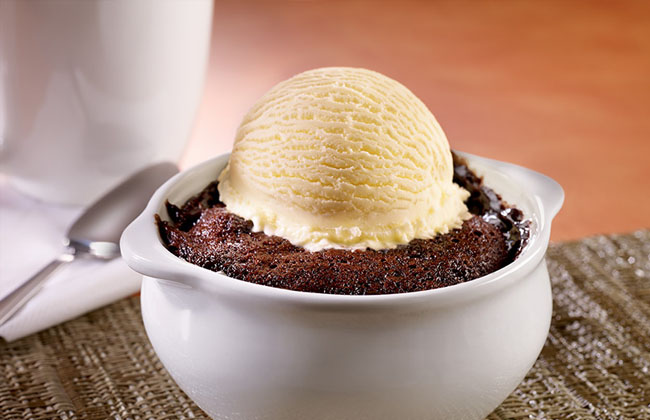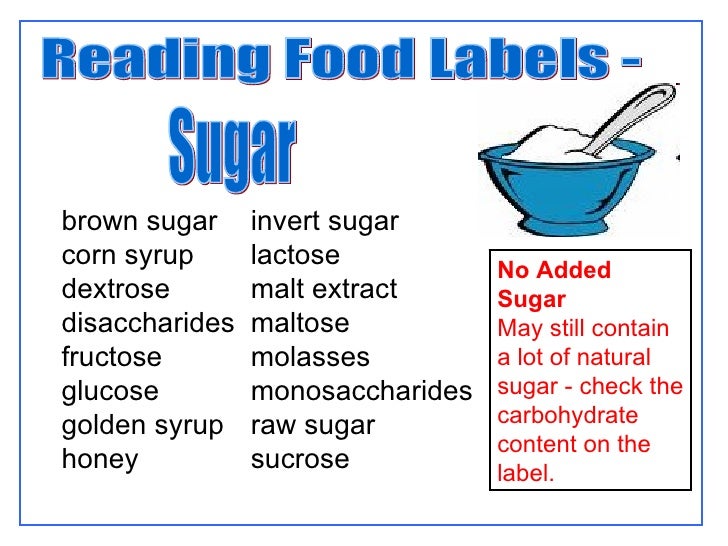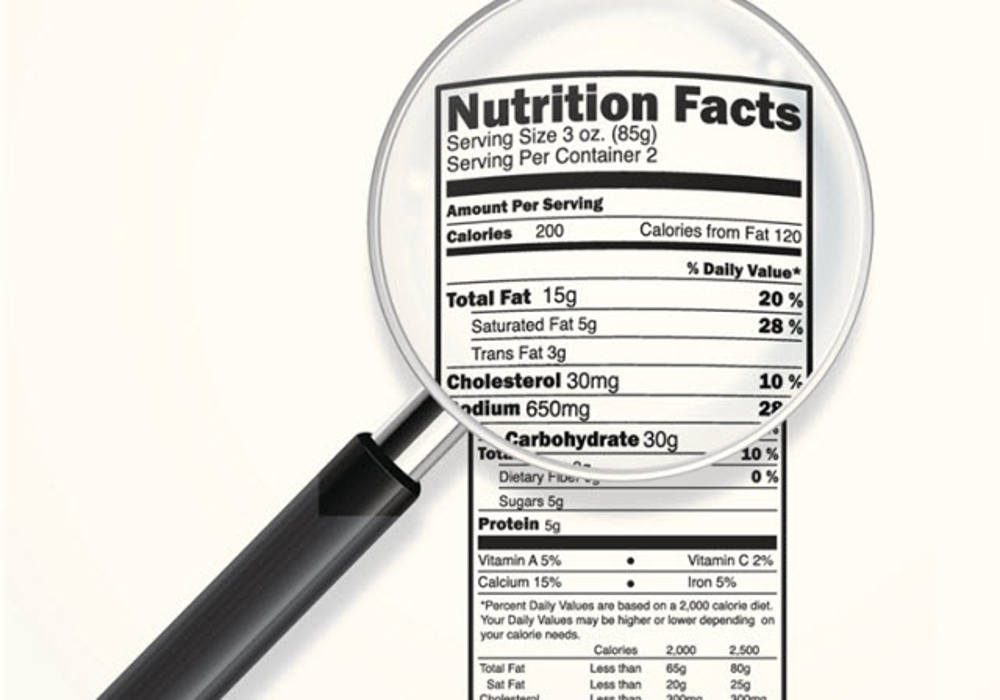45 how to read food labels for sugar content
Added Sugars on the New Nutrition Facts Label | FDA Single-Ingredient Sugars and Syrups Sample Label Let the Nutrition Facts Label Be Your Guide The new Nutrition Facts label can help you compare and choose foods that are lower in added sugars.... › managing › eat-wellFood Labels | CDC - Centers for Disease Control and Prevention Check the Serving size first. All the numbers on this label are for a 2/3-cup serving. This package has 8 servings. If you eat the whole thing, you are eating 8 times the amount of calories, carbs, fat, etc., shown on the label. Total Carbohydrate shows you types of carbs in the food, including sugar and fiber.
How To Easily Read The Sugar Content On A Food Label 1) Check out the nutritional label on any food packaging and find the amount of total carbohydrate in grams 2) Add the Sugars and Carbs together 3) Subtract the fiber grams. If the fiber is less than <1 gram it may not be listed. 5) Divide the result by 4 (or a 1/4 of)

How to read food labels for sugar content
Food Labels (for Teens) - Nemours KidsHealth Food labels provide more than just nutrition facts. They also tell you what's in a packaged food (i.e., the ingredients). People with food allergies need to check ingredient lists to avoid foods that can cause an allergic reaction. Some food labels also state which country the food came from, whether the food is organic, and certain health claims. How to Understand and Use the Nutrition Facts Label | FDA manufacturers are encouraged, but not required, to use the "†" symbol immediately following the added sugars percent daily value on single-ingredient sugars, which would lead to a footnote... How to Read Food Labels Without Being Tricked - Healthline This label usually means that the fat has been reduced at the cost of adding more sugar. Be very careful and read the ingredients list. Low-carb. Recently, low-carb diets have been linked to...
How to read food labels for sugar content. Food Labels | CDC - Centers for Disease Control and Prevention 23.04.2021 · Understanding the Nutrition Facts label on food items can help you make healthier choices. The label breaks down the amount of calories, carbs, fat, fiber, protein, and vitamins per serving of the food, making it easier to compare the nutrition of similar products. Be sure to look at different brands of the same foods—nutrition information can differ a lot. For example, one … Food labels - NHS sugars content salt content These labels provide information on the number of grams of fat, saturated fat, sugars and salt, and the amount of energy (in kJ and kcal) in a serving or portion of the food. But be aware that the manufacturer's idea of a portion may be different from yours. › articles › 249413Healthy blood glucose levels: Targets, extremes, and ... Apr 21, 2022 · The sugar goes straight from the digestive system into the bloodstream after an individual consumes and digests food. However, glucose can only enter cells if enough insulin is also circulating in ... Understanding Food Nutrition Labels | American Heart Association Remember that the information shown in the label is based on a diet of 2,000 calories a day. You may need less or more than 2,000 calories depending upon your age, gender, activity level, and whether you're trying to lose, gain or maintain your weight. When the Nutrition Facts label says a food contains "0 g" of trans fat, but includes ...
kidshealth.org › en › teensFood Labels (for Teens) - Nemours KidsHealth Food labels provide more than just nutrition facts. They also tell you what's in a packaged food (i.e., the ingredients). People with food allergies need to check ingredient lists to avoid foods that can cause an allergic reaction. Some food labels also state which country the food came from, whether the food is organic, and certain health claims. Reading Food Labels | ADA - American Diabetes Association The Nutrition Facts labels on foods are really the key to making the best choices. We'll cover the basics so that these labels make shopping easier for you. You've heard it all. From carb-free to low-carb, to whole and empty carbs, it's hard to know what it all means. Blood sugar highs and lows aren't always easy to understand. How to read food labels: MedlinePlus Medical Encyclopedia Always check the serving size first. All the information on the label is based on the serving size. Many packages contain more than 1 serving. For example, the serving size for spaghetti is most often 2 ounces (56 grams) uncooked, or 1 cup (0.24 liters) cooked. If you eat 2 cups (0.48 liters) at a meal, you are eating 2 servings. How to Read a Food Label to Make Sure It's Keto in 3 Easy Steps 1. Look for a brand that indicates "No Sugar Added". Read the ingredient list to verify. Pederson's brand with the No Sugar-Whole30 Approved seal is my personal choice. 2. Go to the butcher. You can find him in the grocery store by the meat section or at your local butcher shop.
Understanding food labels - Canada.ca Find information on food labels and how to understand them. Learn about nutrition facts tables, serving size, list of ingredients, % daily value and nutrition claims. Find information on food labels and how to understand them. Learn about nutrition facts tables, serving size, list of ingredients, % daily value and nutrition claims. Skip to main content; Skip to "About government" Language ... › en › healthy-livingUnderstanding Ingredients on Food Labels | American Heart ... Mar 06, 2017 · There are many terms used for sugar on food labels. You might see sugar listed as the fourth ingredient in a product and think it’s not so bad. But sugar can also be listed as high-fructose corn syrup or corn syrup, agave nectar, barley malt syrup or dehydrated cane juice, to name just a few. Read more about sugar and sweeteners. › health › how-read-food-andHow To Read Food and Beverage Labels | National Institute on ... Feb 24, 2022 · The % DV information is not calculated with the unique needs of older adults in mind. Read the nutrition label as a whole to determine how a particular food or drink fits into your healthy eating pattern. Is lower % DV always healthier? If a food has 5% DV or less of a nutrient per serving, it is considered low in that nutrient. If it has 20% ... Reading food labels: Tips if you have diabetes - Mayo Clinic Look for foods with 3 or more grams of fiber. Put sugar-free products in their place Sugar-free doesn't mean carbohydrate-free. Sugar-free foods may play a role in your diabetes diet, but remember that it's equally important to consider carbohydrates as well. A sugar-free label means that one serving has less than 0.5 grams of sugar.
How to Read Nutrition Labels for Sugar - hekagoodfoods The number of grams of sugar. Keep in mind, one gram of sugar is roughly equivalent to 1/4 teaspoon of sugar. A percentage indicating how much of your recommended daily intake the item contains. While this is helpful to reference, the FDA recommends natural and added sugars account for no more than 10% of your daily caloric intake.
Understanding food labels - Action on Sugar HOW MUCH SUGAR IS IN YOUR FOOD/DRINK? Step 1 - Calculate amount of sugars per gram by dividing the amount of sugars per 100g OR 100ml by 100. Step 2 - Check the weight of a recommended portion as stated on the pack. Step 3 - Work out the amount of there is per portion by multiplying the figures from step 1 and 2.
How To Read Food and Beverage Labels - National Institute on … 24.02.2022 · Reading food labels can help you make smart food choices. Learn how to read and understand the product date, ingredient list, and Nutrition Facts label. Reading food labels can help you make smart food choices. Learn how to read and understand the product date, ingredient list, and Nutrition Facts label. Skip to main content An official website of the United …
Sugar Savvy: How To Read Food Labels - Elsa Jones < 5g of sugar per 100g = low sugar content. 5g - 15g sugar per 100g = medium sugar content >15g of sugar per 100g = high sugar content . Note Re. Naturally Occurring Sugars. If you're trying to calculate sugar content on a food label, it's important to bear in mind that in many cases, not all of what you see is 'added sugar'.
How to understand food labels | Eat For Health The Nutrition Information Panel on a food label offers the simplest and easiest way to choose foods with less saturated fat, salt (sodium), added sugars and kilojoules, and more fibre. It can also be used to decide how large one serve of a food group choice or discretionary food would be and whether it's worth the kilojoules.
Learning To Read Labels :: Diabetes Education Online On a nutrition food label, subtract the fiber from the total carbohydrate amount. When you read food labels, the grams of sugar are already included in the total carbohydrate amount, so you do not need to count this sugar amount separately. The grams of sugar listed include both natural sugars, from fruit or milk, and added sugars.
How to Understand and Use the Nutrition Facts Label | FDA - U.S. Food … 25.02.2022 · People look at food labels for a variety of reasons. But whatever the reason, many consumers would like to know how to use this information more effectively and easily. The following label-reading ...
Understanding Food Labels | The Nutrition Source | Harvard T.H. Chan ... These statements describe the nutrients in a food beyond what is listed on the Nutrition Facts label, intended to showcase a health benefit of the food. An example is "Contains 100% Vitamin C.". Most terms like "low sodium," "high fiber," "reduced fat," and "good source of" are regulated by the FDA, and the nutrient amounts ...
Understanding food labels | Diabetes UK The labels show how many calories are in the food or drink and are also colour coded to show whether the food is low (green), medium (amber) or high (red) in fat, saturated fat, sugar and salt. The information on the front of the pack also tells you how the portion of the food contributes to the Reference Intake (RI) of an adult. Try to choose foods with more greens and ambers and …
Nutrition labels required by end 2023 for freshly prepared drinks that ... SINGAPORE: Food and beverage outlets will by end of 2023 be required to include nutrition labels on their menus indicating drinks that contain higher levels of sugar and saturated fat. These ...
How to Identify Sugar on Nutrition Labels | Days To Fitness Step 3 - Compare the sugar content of similar food products. A very effective way to see how much sugar is in the food you are eating is to compare product labels side by side. For example, take a no-added-sugar cereal and a regular breakfast cereal and compare total sugar per same-sized serving. You'll often be surprised at the difference.
How to Read Carbohydrates on Food Labels - GlycoLeap That would be around 15 to 30 g of carbohydrates. Snack = 15 - 30 g of carbohydrate. For the main meals (breakfast, lunch, dinner), 2 to 3 servings of carbs would be enough. That is about 30-45 g of carbohydrates. 3 servings of carbohydrates are about the size of 1 fist size of rice.
Understanding food labels | Diabetes UK Check the ingredients list - if syrup, invert syrup, cane sugar, molasses or anything ending in 'ose' is within the first three ingredients, this suggests the food contains more added sugar. Choose an alternative if possible, or be mindful of the portion you eat. Check the fibre content on the back of pack label.

39 Where Would You Look On The Food Label To Determine If Sugar Was Added To The Product Quizlet ...
Sugars on food labels - Sugar Nutrition Resource Centre Sugars and the Nutrition Information Panel The Nutrient Information Panel on the back of the pack, shows detailed information on the average amount of energy, protein, fat, saturated fat, carbohydrate, sugars and sodium (a component of salt) in the food, as well as any other claim that requires nutrition information.
How To Read Food labels for Sugar | My Sugar Free Kitchen On the label check the sugars in the nutrition panel. 5g/ml or less of sugar per 100g/ml = this would count as low sugar content. It means 5% of the ingredients are sugar Between 5g/ml and 20g/ml of sugar per 100 grams = medium sugar content. With 20ml of sugar per 100 ml, this means the product is 20% sugar…not so good.
Understanding sugar content on food labels - Diabetes Care Community Reading the ingredient lists and nutrition facts tables on packaged foods is a helpful way for you to check what kind, and how much, sugar a product has. Finding sugar content in the ingredients list The ingredients are listed in order of weight, beginning with the ingredient that weighs the most and ending with the ingredient that weighs the ...
How to read labels for added sugar - That Sugar Movement One: Look for foods under 5g total sugar/100g In Australia, the Nutrition Information Panel (NIP) on the back of food and drink packaging lists total sugars content. It does not separate intrinsic sugars from added sugars. Yet, it is the added sugars - not those that are intrinsic or naturally-occurring in whole foods - that we are concerned with.
Nutrition labels required by end-2023 for freshly prepared drinks ... Vor 1 Tag · SINGAPORE — Food-and-beverage outlets will by end of 2023 be required to include nutrition labels on their menus indicating drinks that contain higher levels of …














Post a Comment for "45 how to read food labels for sugar content"